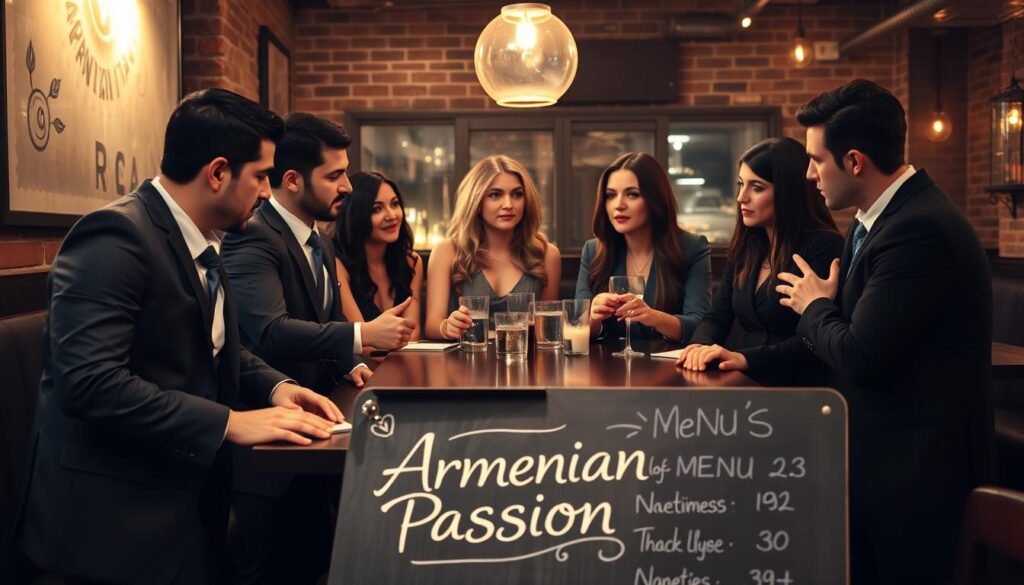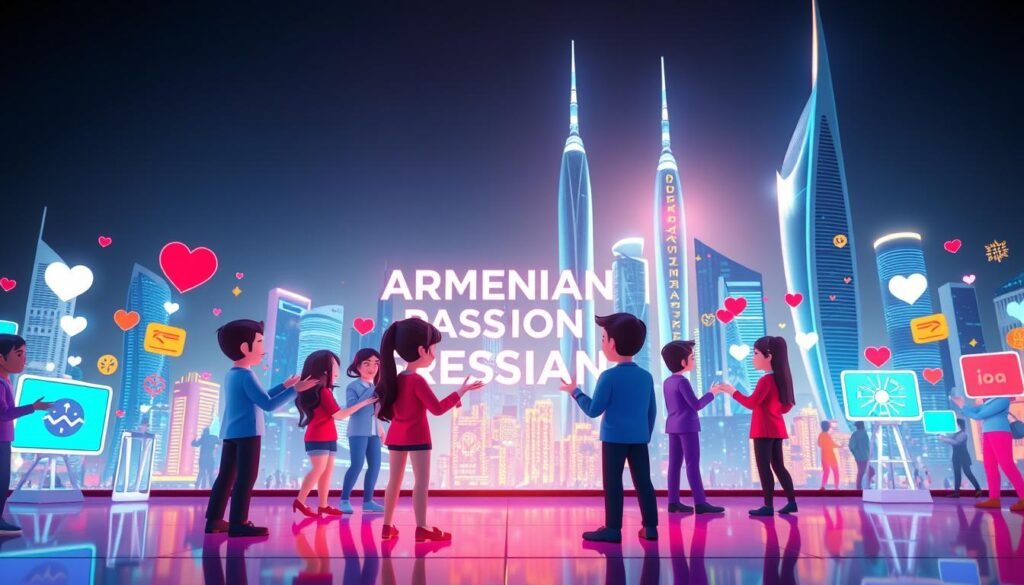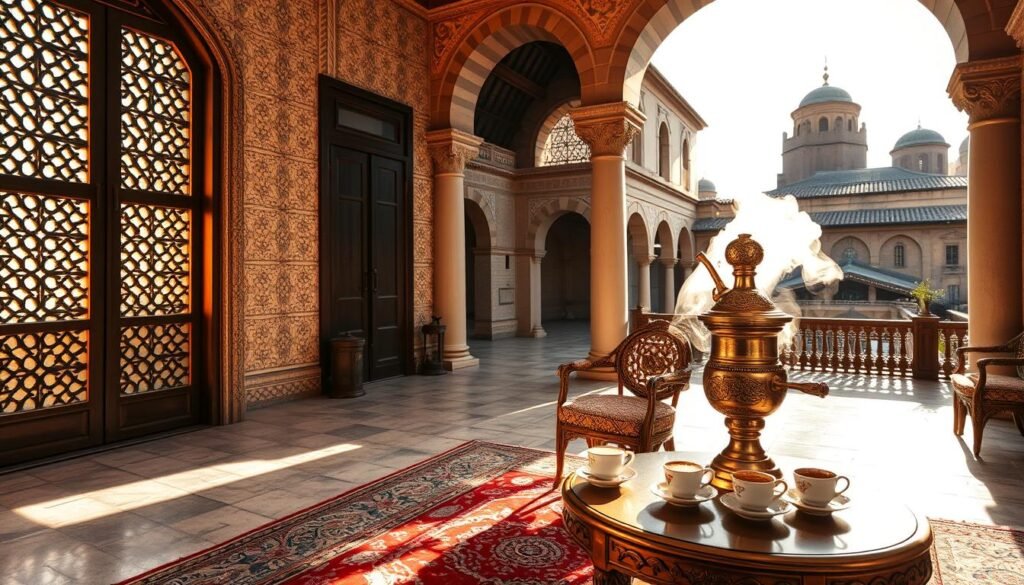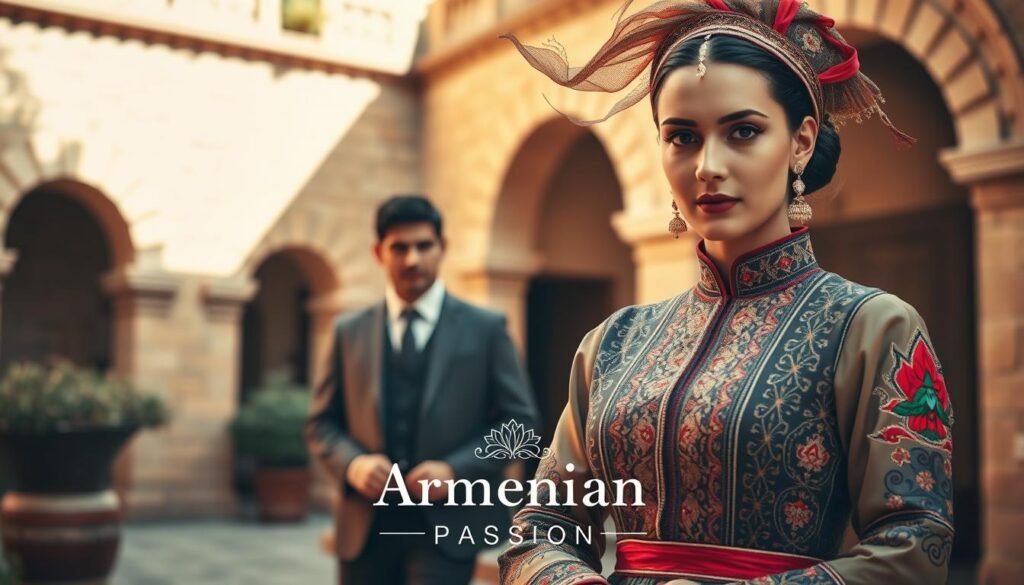Did you know saying “hello” in Armenia can help you connect with Armenian singles? Learning Armenian greetings can change how you interact with people. It’s not just about saying “hello.” It’s about showing respect for Armenian culture.
When you meet someone new or join community events, knowing these customs is key. It shows you value their culture. Armenian Passion helps you find people who share these cultural values. This makes every meeting special.
Key Takeaways
- Armenian greetings carry deep cultural significance beyond simple pleasantries.
- Traditional Armenian greetings vary by context, from casual to formal settings.
- Learning proper phrases helps build trust with Armenian singles and communities.
- Language skills improve your chances of meaningful connections on platforms like Armenian Passion.
- Missteps in greeting can unintentionally send the wrong message.
Understanding the Importance of Armenian Greetings in Cultural Connections
Armenian greetings are more than just saying hello. They open doors to understanding each other’s culture. These greetings help build trust and respect, which are key in Armenian social etiquette.
They shape how people interact, from everyday conversations to important meetings.
The Role of Proper Greetings in Armenian Social Etiquette
In Armenian culture, how you greet someone sets the tone for your relationship. Saying “Barev dzez” (Good morning) or “Voghormut yev shnorhakalutyun” (Hello and thank you) shows respect. Getting greetings right is important to avoid misunderstandings.
Thoughtful greetings lead to real connections. Even a simple “Shnorhan” (Thank you) shows humility, a valued trait in Armenian culture.
How Greetings Reflect Armenian Cultural Values
“The guide on Armenian greetings emphasizes the significance of mastering essential phrases for cultural connections,” states Ararat Travel. Phrases like “Sis em” (How are you?) show more than just a question. They reflect Armenian cultural values like hospitality and family ties. Elders are respected with special language, strengthening family bonds.
The Connection Between Language and Community in Armenian Culture
Language brings Armenians together worldwide. Learning basic greetings like “Araik” (See you later) or “Tsaghik” (My friend) connects people across ages and places. For those exploring Armenian culture or dating, these phrases help them feel part of the community.
Armenian Passion, a platform for global Armenians, shows how mastering these customs strengthens Armenian community customs. Small actions, like eye contact during a handshake, show respect and shared identity.
Basic Everyday Armenian Greetings You Should Know
Learning common Armenian greetings helps you connect with others. Start with the simple Armenian hello: “Barev” (bah-rehv).) It’s perfect for any time of day. To say “Hello to you,” reply with “Barev dzez” (bah-rehv jehz).
Ask “How are you?” with “Vonts es?” (vohnch ess). Say “Harach e” (hah-rahch eh) to thank someone. It shows you appreciate their help.
- Barev – “Hello” (casual, universal)
- Barev dzez – Formal response to “Barev” (barev dzez meaning emphasizes respect)
- Unc em? – “Good morning” (oonch em?)
- Unc ayl em? – “Good afternoon/evening” (oonch eye-lem?)
Practice these Armenian greeting phrases to connect better. On Armenian Passion, saying “Barev” starts a friendly conversation. Even small efforts with these common Armenian greetings show you care.
Use “Shnorhakalutyun” (shnohr-ha-khlootyoohn) for “Thank you” in formal situations. Mixing these phrases makes talking easier. Remember, trying is what counts!
How Do You Greet Someone in Armenia? Essential Phrases for Every Situation
Learning Armenian greetings is about understanding social, professional, and cultural norms. Whether it’s a colleague or a friend, the right phrases show respect and build trust. Here’s how to greet in any situation.
Formal Greetings for Professional Settings
In business, Armenian greetings are all about respect and professionalism. Start with “Բարեւ ձեզ” (Barayv dzez, “Hello to you”) or “Բարև ձեզ” (Barayv dzez) to be polite. When introducing yourself, say “Ես եմ…” (Yes em) and then your name.
Being on time and making eye contact are also key in Armenian Armenian business greetings.
Casual Greetings Among Friends and Family
With friends and family, use informal greetings like “ԳերաUrlParser երեւաnn” (Gerevank erewan, “Good evening”) or the casual “Բարև” (Barayv). Add humor or local slang, like “Ինչպես” (Inchpes, “How’s it going?”), to show you’re comfortable and familiar.
Regional Greeting Variations
Armenian dialects vary by region. In Yerevan, Eastern Armenian speakers say “Բարև ձեզ”. But in Lebanon or the US, Western Armenian speakers use “Բարեւ ձեզ”. Knowing these regional Armenian dialects helps you connect with Armenians everywhere. Sites like Armenian Passion show these differences.
Time-Specific Greetings Throughout the Day
- Morning: Use “Բարեւ առավոտին” (Barayv aravotin, Armenian morning greetings)
- Afternoon: “Դիմերը լավ են?” (Dimer guh lav en?, “How’s the day going?”)
- Evening: “Իմ ամորակը” (Im amorak, “Good evening”)
Knowing the right phrases for different times of day shows you care about Armenian culture. This is important for making connections, whether on Armenian Passion or in cultural exchanges.
The Art of Physical Greetings: Handshakes, Hugs, and Kisses
Armenian greeting customs mix tradition and warmth, seen in physical gestures. Meeting someone online or in person, knowing these customs builds trust.
Gender Considerations in Armenian Physical Greetings
Armenian handshake etiquette changes with gender. Men usually shake hands firmly, sometimes followed by a cheek kiss. Between genders, a light handshake or nod is common in formal settings. Always mirror the other person’s greeting to show respect.
Decoding Embraces and Kisses
- A single cheek kiss shows basic friendliness.
- Three kisses—left, right, left—mean a deeper connection or familiarity.
Cheek kissing in Armenia is personal; ask first if unsure. Hugs are for friends but reserved for close ones.
Generational Differences Matter
Younger Armenians might use Western-style handshakes or high-fives. Older generations stick to traditional ways. Knowing someone’s background, like through Armenian Passion, helps avoid misunderstandings.
Respecting these cues makes your interactions feel real. Whether online or offline, understanding cultural norms opens doors to meaningful connections.
Special Occasion Greetings in Armenian Culture
Armenian holiday greetings are more than words. They connect us to the heart of Armenian culture. Whether it’s birthdays, religious holidays, or weddings, the right phrases make a big difference. They mix tradition with warmth, leaving a lasting impression.
| Occasion | Greeting | Meaning |
|---|---|---|
| Birthday | “Shnorhavor nor yervantarich” | Birthday greetings in Armenian meaning “Happy new year of life” |
| Christmas (Kardash) | “Kaghandare” | “Merry Christmas” |
| Easter (Trdagan) | “Kristos havorum” | “Christ is risen!” |
| Wedding | “Areni gorts” | “May your life be as red as a rose” |
“A heartfelt Armenian festive expression can spark deeper conversations.”
Armenian celebration phrases are rooted in tradition and hope. Saying “Nor yerkir” (Happy New Year) during Christmas or Easter shows respect. Sharing these moments on Armenian Passion can strengthen bonds.
Using the right words, like “Shnorhavor nor yervantarich” for birthdays or “Kaghandare” for Christmas, honors Armenian heritage. These moments bring joy to our relationships, whether in person or online.
Common Mistakes to Avoid When Greeting Armenian Singles
Understanding cultural etiquette Armenia is key to making a good first impression. Even small mistakes like Armenian greeting mistakes can harm social bonds. Whether you meet people in person or online on Armenian Passion, knowing what to avoid helps. Here’s how to handle Armenian dating etiquette with confidence.

Cultural Faux Pas That Could Make a Bad First Impression
Avoid these common mistakes to prevent misunderstandings:
- Using Turkish phrases like “Merhaba” instead of Armenian “Բարեւ” (Barev) due to historical sensitivities.
- Initiating hugs or kisses without knowing the relationship level—wait for cues from the other person.
- Mixing formal greetings like “Բարեւ դուք” (formal) with casual settings or vice versa.
How to Recover Gracefully From Greeting Mistakes
If you make a mistake:
- Smile and say, “Oh, I meant to say…” to correct errors quickly.
- Ask, “Could you teach me the right way?” to show eagerness to learn.
- Use light humor: “I’m learning—please help me!” works in most cases.
Tips for Non-Armenians Meeting Armenian Community Members
Follow these strategies to build trust:
- Start with neutral greetings like “Barev” to avoid overstepping.
- Observe body language—eye contact shows respect but over-staring may feel intense.
- Join Armenian Passion’s cultural guides to practice phrases and connect with members who value kindness over perfection.
Connecting Through Language: How Armenian Greetings Build Relationships
In Armenian culture, greetings are more than words—they’re bridges between people. The Armenian language connection builds trust. Greeting someone in Armenian honors their heritage, starting cultural bonding Armenia that goes deep.
This practice follows Armenian communication customs. Respect and sincerity are key to relationship building Armenian culture.
“A sincere greeting isn’t just words—it’s a step toward understanding.” – Armenian Passion Team
- Use formal greetings like “Բարեւ ձեզ” (Barev dzez) in professional settings to show respect.
- In casual settings, add warmth with phrases like “Շնորհակալություն” (Shnorhakalutyun) to express gratitude naturally.
- Match body language—eye contact and smiles reinforce sincerity.
Armenian Passion knows these details. Their platform shows how mastering greetings connects people deeply with tradition. When you respect culture, you open doors to deeper relationships based on mutual appreciation.
Modern Armenian Greetings in Digital Communication
Armenian online greetings and text messages have changed with digital tech. They mix old traditions with new tech. When texting friends or meeting new people on sites like Armenian Passion, knowing the right etiquette is key to making connections.

Text and Social Media Greetings in Armenian
| Traditional | Digital |
|---|---|
| “Բարեւ ձեզ” (Barev dzez) – Formal “Hello” | “Բարեւ!” + 😊 – Casual text with emojis |
| Handwritten letters | Shortened phrases like “Բարեւ, կարդացել ե՞ր” (Barev, kardacel yer?) – “Hi, have you read?” for casual check-ins |
Use Armenian text messages with emojis to show warmth. But don’t overdo it with abbreviations unless you’re sure the other person knows them.
Create a Strong First Impression on Armenian Passion
- Start with “Բարեւ!” (Barev!) or “Իմանալ ե՞ր” (Imanal yer?) – “Nice to meet you?”
- Mention shared interests: “Ուզում ե՞ր հաճախորդի մասին” (Uzum yer hajakhordi masin?) – “Interested in discussing travel?”
- Avoid overly formal language unless in Armenian dating site etiquette requires it
Armenian Passion values cultural sensitivity. This makes it easier to connect with respectful Armenian online greetings.
Maintain Engaging Online Conversations
- Respond quickly to show you’re interested in digital communication Armenia
- Ask open-ended questions: “Ի՞նչ միասին ուզե՞ք” (Inch miasin uzek? – “What do you enjoy doing?”)
- Avoid personal questions until trust builds
Respect time zones and cultural differences to build trust. Armenian Passion’s community guides offer tips for smooth interactions.
Learning Resources to Perfect Your Armenian Greeting Skills
Mastering Armenian greetings starts with the right Armenian language resources. Start with free apps like Duolingo or Memrise. They have Armenian language apps modules for everyday phrases. Also, watch YouTube channels like “Learn Armenian with Anna” for tips on pronunciation and culture.
- Practice with Armenian greeting practice exercises on platforms like Tandem. Here, you can get feedback from native speakers.
- Check out books like “Armenian Phrases for Travelers” for structured learn Armenian greetings lessons.
For more practice, join online forums like Reddit’s r/LearnArmenian or Facebook groups for language exchange. Armenian language apps like Pimsleur offer audio drills to boost your confidence. Start using what you learn in real-life chats. Armenian Passion members say starting with proper greetings makes a great first impression.
Remember, even small efforts count. Saying “Բարեւ Ձեզ” (barev dzez) shows respect. Focus on being consistent, not perfect. Every try brings you closer to the culture and people.
Conclusion: Embracing Armenian Culture Through Authentic Greetings
Learning Armenian greetings is more than just saying hello. It’s about building Armenian cultural connections based on respect and shared heritage. Saying “barev” or “sun-u-lesh” with a smile can start deep relationships. Even small steps, like learning “shnorhakalut’yun” (thank you), show you care, making interactions real.
When you understand Armenian culture, connecting with singles becomes easier. Sites like ArmenianPassion.com are great for showing off your skills. With over 100,000 members, a warm greeting can start a meaningful conversation. Remember, being yourself is more important than being perfect. Armenians value effort over perfection, so start small and grow.
Mastering Armenian greetings opens doors to new friendships and love. ArmenianPassion.com is a top choice for those who value cultural connection. Take the first step today. Your next “hello” could start a beautiful story. Share your culture with confidence and find meaningful connections.
FAQ
What are some common Armenian greetings I should know?
You should know “Barev” (Hello), “Barev dzez” (Hello to you – formal), and “Vonts es?” (How are you?). These greetings are great for starting conversations with Armenian singles. They show you’re interested in their culture.
How important are greetings in Armenian culture?
Greetings are very important in Armenian culture. They show respect and social standing. They also reflect values like hospitality and community, helping to build real connections with Armenian singles.
What should I avoid when greeting Armenian singles?
Avoid using Turkish phrases, as they might be sensitive due to history. Also, be careful with physical contact, depending on the setting and gender.
Are there different greetings for formal and casual situations?
Yes, there are. Formal greetings are for work or meeting elders. Casual greetings are for friends and family. Knowing this can make your interactions better with Armenian singles.
How do physical greetings differ across generations in Armenia?
Younger Armenians might use Western-style greetings like light handshakes or hugs. Older generations might prefer firmer handshakes or cheek kisses, showing cultural diversity.
What special greetings should I know for Armenian holidays?
For holidays like Christmas, Easter, and New Year, use special greetings that wish good wishes and joy. Knowing these can show your thoughtfulness and cultural awareness during celebrations.
How can I make a great first impression on the Armenian Passion platform?
Start with a friendly greeting that shows you understand Armenian culture. Personalize your messages and show real interest in the other person’s background. This can help make a positive first connection.
What resources can help me improve my Armenian greeting skills?
Use language learning apps, YouTube channels, and online communities for conversational Armenian. Practicing with native speakers, like those on Armenian Passion, is also very helpful.
Can learning Armenian greetings help build deeper relationships?
Absolutely! Learning and using Armenian greetings shows respect for their culture and heritage. This can greatly improve trust and connection with Armenian singles, leading to more meaningful relationships.




